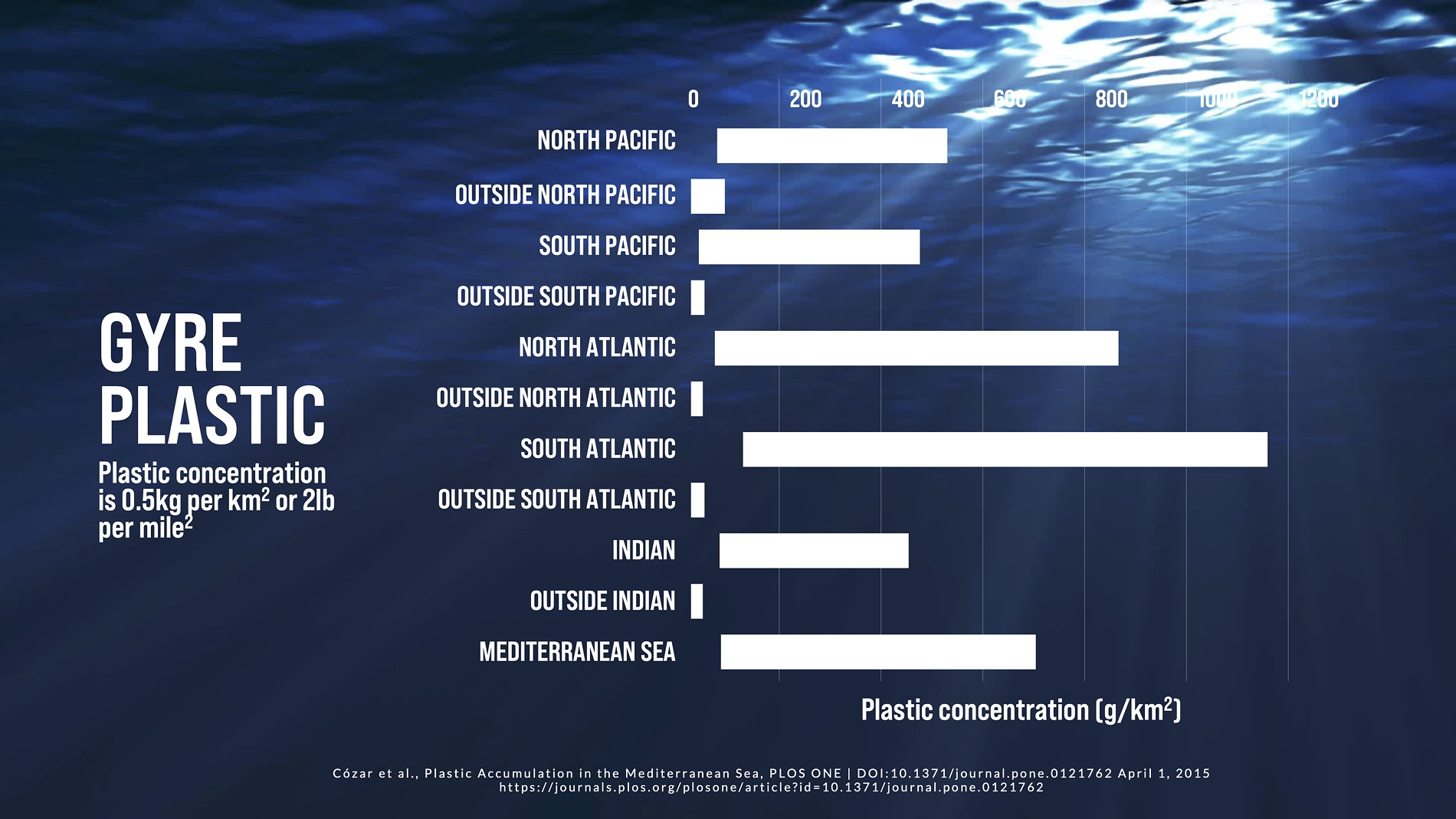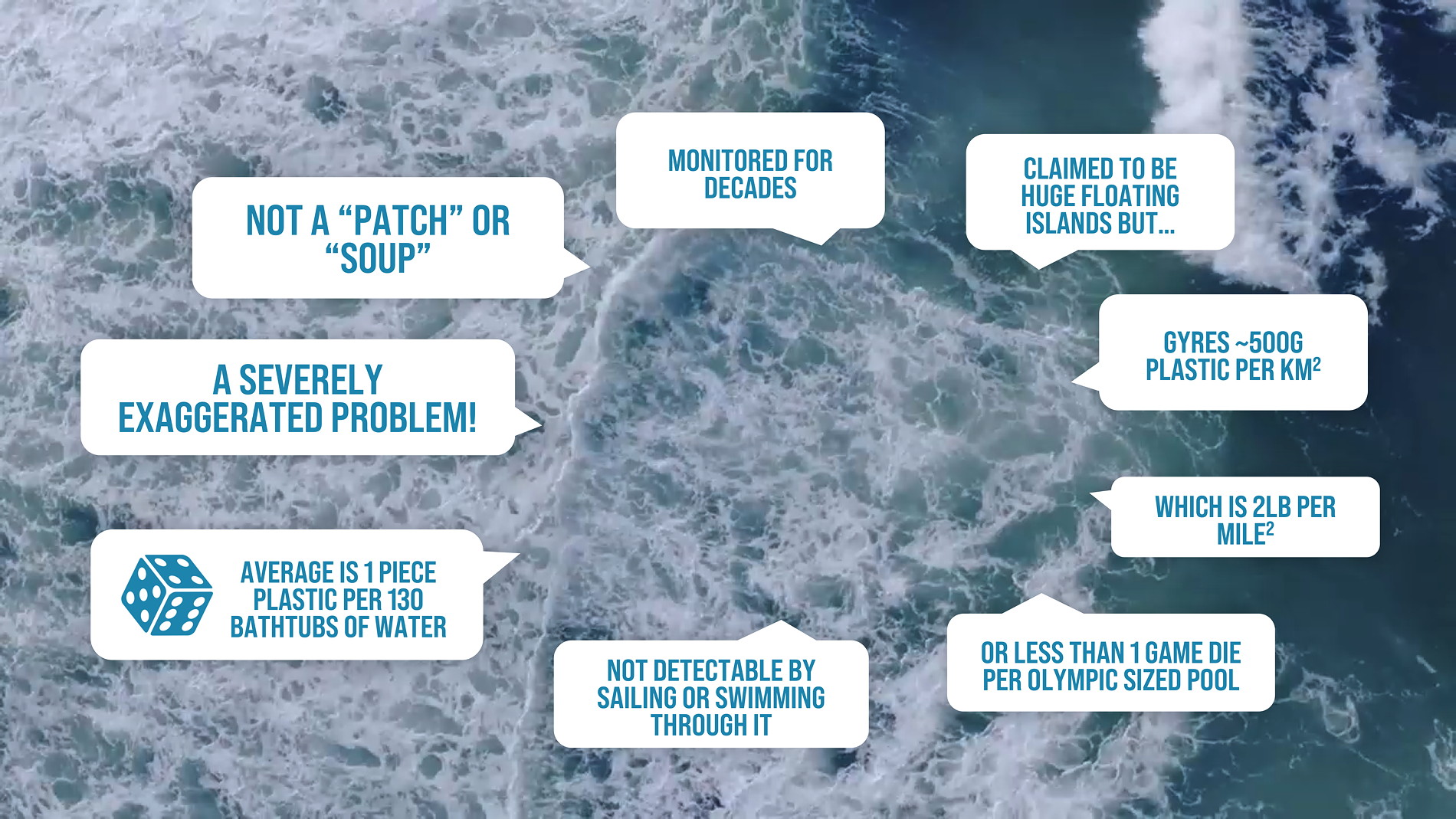Ocean Plastic: Patches or Gyres
Ocean plastic is drawing huge amounts of international attention. We have all been told about the huge floating islands of plastics the size of countries. Here is one example –
“…the Great Pacific Garbage Patch in the North Pacific Ocean is less like a patch and more like a massive swirling vortex more than three times the size of Spain and more than twice the size of Turkey or Texas.”
businessinsider.com/great-pacific-garbage-patch-view-study-plastic-2018-3
This conjures up a powerful image and rallies the public to action. I was therefore surprised to read what the National Ocean Service (NOAA) had to say.
“A lot of people hear the word patch and they immediately think of almost like a blanket of trash that can easily be scooped up, but actually these areas are always moving and changing with the currents, and it’s mostly these tiny plastics that you can’t immediately see with the naked eye.” – Diana Parker NOAA
oceanservice.noaa.gov/podcast/mar18/nop14-ocean-garbage-patches.html
So, apparently, there are no floating islands, instead, there are areas that contain tiny pieces of plastic. Dianna Parker was then asked about the “plastic soup” and this is what she had to say:
“These are tiny plastics that you might not even see if you sailed through the middle of the garbage patch, they’re so small and mixed throughout the water column.”
You may have seen people claiming that we can use ships to scoop up the marine pollution but that does not work. The debris is far too dilute and it would mean sailing hundreds of ships which burn diesel while belching out smoke and carbon dioxide. Such efforts cause more harm than good and are ineffective anyway.
“We did some quick calculations that if you tried to clean up less than one percent of the North Pacific Ocean it would take 67 ships one year to clean up that portion. And the bottom line is that until we prevent debris from entering the ocean at the source, it’s just going to keep congregating in these areas. We could go out and clean it all up and then still have the same problem on our hands as long as there’s debris entering the ocean.”
Dianna Parker NOAA
How much would it cost to attempt a clean-up using ships? Here are some calculations I found online.
“Suppose we were to attempt to clean up less than 1% of the North Pacific Ocean (a 3-degree swath between 30° and 35°N and 150° to 180°W), which would be approximately 1,000,000 km2. Assume we hired a boat with an 18 ft (5.5 m) beam and surveyed the area within 100 m off of each side of the ship. If the ship traveled at 11 knots (20 km/hour), and surveyed during daylight hours (approximately 10 hours a day), it would take 67 ships one year to cover that area! At a cost of $5,000-20,000/day, it would cost between $122M and $489M for the year. That’s a lot of money—and that’s only for boat time. It doesn’t include equipment or labor costs (keep in mind that not all debris items can be scooped up with a net).”
Carey Morishige, Pacific Islands Regional Coordinator, NOAA Marine Debris Program
That was news to me. She is saying that there is so little plastic in the so-called patches that you can’t even tell they are there. So I went looking for peer-reviewed scientific studies to find out just how much plastic there really is. I found a study giving an overview of several studies covering all the patches. It turns out that scientists have been studying these areas for decades and millions of measurements have been made. What do the scientists report about the concentration of plastic fragments? The scientists show that the average amount of plastic in the oceans overall is around 10g per square kilometer. That’s about 1 ounce of plastic per square mile of ocean. I was surprised at how little that was.
Clearly, we don’t want litter of any kind in our oceans but the amount seemed remarkably low compared to what I expected from media coverage. The data showed that there is far more plastic in the patches, but how much more? Looking at all the studies, the worst areas contain 500g of plastic per square kilometer of ocean on average and at most around 1000g per square kilometer. That’s about 2-4lb per square mile of ocean. It’s hard to imagine a square kilometer, so let’s pick an area we can relate to. An Olympic swimming pool measures 50m x 25m which is 0.00125 square kilometers in surface area. That means that if we were to drop a 5g plastic die from a board game into an Olympic pool, that would be more plastic than we find in the same amount of ocean.

Let me say that again – the worst areas of ocean “patches” contain less plastic than 5g per Olympic pool of water
The ocean patches are often referred to as a plastic soup. If it is a soup, then it’s the weakest soup I’ve ever heard of. If you were to pour a bathtub of this “soup” it would not contain one single piece of plastic. That’s not a soup, that’s just water! On average they found just 1 piece of plastic per 130 bathtubs of water and at most 1 small plastic fragment per 3 bathtubs of water.
Let us hear what the scientists had to say when reviewing the actual data from their measurements:
“The discovery of large-scale accumulations of marine debris has attracted worldwide attention in the media, which often refer to these areas as “great garbage patches”. However, these marine plastic accumulations are inaccurately illustrated in some media reports.”
Source: Cózar A, Sanz-Martín M, Martí E, González-Gordillo JI, Ubeda B, Gálvez JÁ, et al.
(2015) Plastic Accumulation in the Mediterranean Sea. PLoS ONE 10(4): e0121762. doi:10.1371/ journal.pone.0121762
The scientists are politely saying that we’ve been lied to
A new study says that the amount of plastic entering the oceans has been massively overestimated:
“…a number of research institutions in France and the University of Barcelona in Spain demonstrate that current river flux assessments are overestimated by two to three orders of magnitude from previous estimates”.
They are saying that the amount of plastic entering the oceans was overestimated by between 100 and 1000 times!
In fact, there is a PhD thesis by Kim De Wolff that tells the story of how the myth of floating islands of plastic was born and how reputable publications have repeated the lie without checking the facts. Quote:
“Spelled out in bold font with the science section authority of no less than the New York Times, the November 9th, 2009 headline seems irrefutable: “Afloat in the Ocean, Expanding Islands of Trash.” That journalist Lindsey Hoshaw has just returned from an expedition through the garbage patch in the North Pacific makes the trash island report all the more real. And the New York Times claims are in good company. Time Magazine describes a “swirling mass of plastic debris twice the size of Texas,” human impact on the ocean so severe “You can literally see the result” (Walsh 2008) The garbage patch is crowned “The World’s Largest Landfill” by Discover amidst calls to recognize it as “the 8th continent” (Kostigen 2008). Visible. Solid. Massive. The collective account does not shy from specifics. As reported by ABC News, the San Francisco Chronicle, and even Oprah, among countless others, the garbage patch spans hundreds of miles, is one hundred meters deep, and weighs 3.5 million tons (Berton 2007; Bonfils 2008). It is, following the most recited descriptor, twice the size of Texas. Or, in all its regional variations, “as large as Central Europe” (Pravda 2004), with a “footprint as large as France and Spain combined” (WHIM 2014), even “twice the size of America” (Daily Mail 2008). This floating mass growing in the North Pacific Ocean, northeast of the Hawaiian Islands is surely impossible to miss. But despite general agreement on its location and the proliferation of claims about its size, no one can find it; not on Google Earth, not after weeks at sea. The trash island is not there.”
We are also told that the ocean plastic is accumulating at an ever increasing pace. Is that true? Scientists have been tracking the trends for several decades. This is what they have to say:
“A study of plastic microdebris in waters from the British Isles to Iceland (5) revealed a statistically significant increase in plastic abundance from the 1960s and 1970s to the 1980s and 1990s. However, similar to this study, no significant increase was observed between the later decades despite a large increase in plastic production and disposal.”
So, contrary to what we have been told, there is no upward trend – the evidence exposes yet another lie

Note that these scientists are not alone. Other studies show the same amount of plastic in the gyres. I would agree that we should take care of our oceans but we should start with facts so that we can make wise decisions. It seems to me that certain groups, claiming to be environmentalists, are more interested into scaring us into opening our wallets than they are in protecting the environment.
If we are to really protect the planet for future generations, then we need to check the science and focus on the topics that make most difference. I spent some time checking to see what pollution there is in our oceans and was dismayed to find that millions of tons of munitions were dumped there including chemical weapons and nerve gas. Why is no-one talking about that? Perhaps the fake environmentalists don’t feel there’s money to be made from it.
Rob Edwards, Danger from the deep, New Scientist, 18th November 1995
If you want to be a force for good, then please spend time to check the evidence before you act because that is the only path to progress. Recently, I read about 500 scientific articles about plastic waste, litter, ocean gyres, microplastics and more, so that we can start making wise decisions. That resulted in The Plastics Paradox: Facts for a Brighter Future.
Book Speaking
Engagements
- Have an independent expert explain to your customers why plastics are the solution and not the problem
- Chris can make your employees proud to work with plastics, rather than be ashamed
- Dr. DeArmitt can help you push back against unjust attacks on your company
- Showing the evidence can convince owners and shareholders that your company is on the right course
- Presenting the science can help change public opinion and government policy

